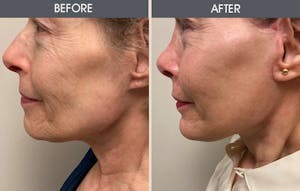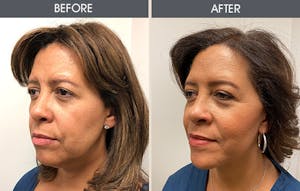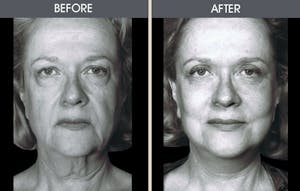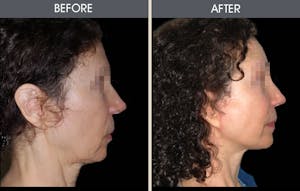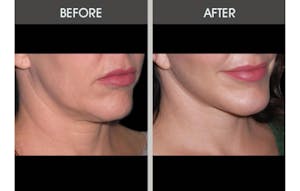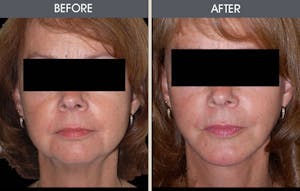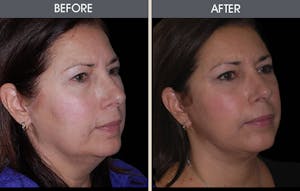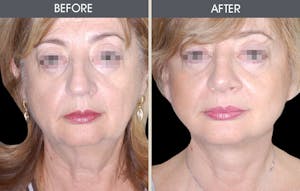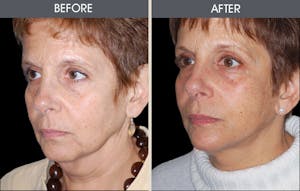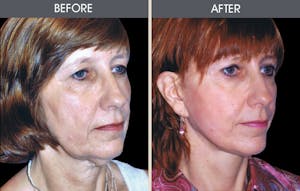Top New York plastic surgeon Dr. Darrick Antell is board-certified in plastic surgery, emphasizing aesthetic cosmetic surgery. One of the procedures he commonly performs is the Mini Facelift.
Mini Facelifts can improve the most visible signs of aging and are particularly valuable for younger patients in their 40s and 50s. Mini Facelifts are appropriate for people who show aging in the mid-face and do not have a severe amount of excess skin around their jawline and neck. If you are considering a short-scar facelift, this section will give you a basic understanding of the procedure.

Considering a Mini Facelift
The Mini Facelift is also known by a variety of different names, such as the s-lift, baby boomer facelift, limited-incision facelift, or mini-lift. It is generally appropriate for people who show aging in the mid-face and do not have a severe amount of excess skin around their jawline and neck. A Mini Facelift cannot stop the aging process. What it can do is "set back the clock," improving the most visible signs of aging. A Mini Facelift can be done alone, or in conjunction with other cosmetic surgery procedures.
If a Mini Facelift sounds appealing, this information will give you a basic understanding of the procedure: when it can help, how it's performed, and what results you can expect.
The best candidates for a Mini Facelift
The Mini Facelift is particularly valuable for younger patients in their 40s and 50s, or as a secondary facelift. It can be combined with liposuction in the neck area to give a remarkable overall improvement.

Schedule a Consultation
ContactIs there a risk with Facelift Surgery?
When a Mini Facelift is performed by a qualified plastic surgeon, complications are infrequent and usually minor. Still, individuals vary greatly in their anatomy, their physical reactions, and their healing abilities, and the outcome is never completely predictable. You can reduce your risks by closely following your surgeon's advice both before and after surgery.

Planning your Mini Facelift
Mini Facelifts are very personalized procedures. In your initial consultation, Dr. Antell will evaluate your face, including the skin and underlying bone, and discuss your goals for the surgery. Your surgeon will check for medical conditions that could cause problems during or after surgery, such as uncontrolled high blood pressure, blood clotting problems, or the tendency to form excessive scars.
Be sure to tell your surgeon if you smoke or are taking any drugs or medications, especially aspirin or other drugs that affect healthy blood clotting. If you decide to have a Mini Facelift, your surgeon will explain the techniques and anesthesia he will use, the type of facility where the surgery will be performed, and the risks and costs involved.
Don't hesitate to ask any questions you may have, especially those regarding your expectations and concerns about the results.

Preparing for your Mini Facelift
Your surgeon will give you specific instructions on how to prepare for surgery, including guidelines on eating and drinking, smoking, and taking or avoiding certain vitamins and medications. Carefully following these instructions will help your surgery go more smoothly. If you smoke, it's especially important to stop at least a week or two before and after surgery; smoking inhibits blood flow to the skin, and can interfere with the healing of your incision areas.
Whether your Mini Facelift is being done on an outpatient or inpatient basis, you should arrange for someone to drive you home after your surgery, and to help you out for a day or two if needed.
Where your Mini Facelift will be performed
A Mini Facelift may be performed in a surgeon's office-based facility, an outpatient surgery center, or a hospital. It's usually done on an outpatient basis, but some surgeons may hospitalize patients for a day when using general anesthesia. Certain conditions such as diabetes or high blood pressure should be monitored after surgery, and may also require a short inpatient stay.
Dr. Antell performs most of his cosmetic surgeries at his own state-of-the-art and accredited surgical facility in New York, allowing for superior care and service, and hands-on attention to perfection.
Types of anesthesia for a Mini Facelift
Most Mini Facelifts are performed under local anesthesia, combined with a sedative to make you drowsy. You'll be awake but relaxed, and your face will be insensitive to pain. Some procedures call for general anesthesia, in which case, you'll sleep through the operation.
The Mini Facelift procedure
The procedure for a short-scar facelift includes repositioning all portions of the face that show signs of aging, but the incision is approximately one-half the length of a traditional facelift incision and eliminates most of the incisions behind the ears. Some people believe that the recovery and bruising after this type of operation are minor compared to that of a traditional facelift. However, this has not been proven in the literature.
Every surgeon approaches the procedure in his or her own way. Some complete one side of the face at a time, and others move back and forth between the sides. The exact placement of incisions and the sequence of events depends on your facial structure and your surgeon's technique.
In general, the surgeon separates the skin from the fat and muscle below. Fat may be trimmed or suctioned from around the neck and chin to improve the contour. The surgeon then tightens the underlying muscle and membrane, pulls the skin back, and removes the excess. Stitches secure the layers of tissue and close the incisions; metal clips may be used on the scalp.
Following surgery, a small, thin tube may be temporarily placed under the skin behind your ear to drain any blood that might collect there. The surgeon may also wrap your head loosely in bandages to minimize bruising and swelling.
After your Mini Facelift
There isn't usually significant discomfort after surgery; if there is, it can be lessened with the pain medication prescribed by your surgeon. (Severe or persistent pain or a sudden swelling of your face should be reported to your surgeon immediately.) Some numbness of the skin is quite normal; it will disappear in a few weeks or months.
Your doctor may tell you to keep your head elevated and as still as possible for a couple of days after surgery, to keep the swelling down. If you've had a drainage tube inserted, it will be removed one or two days after surgery. Bandages, when used, are usually removed after one to five days. Don't be surprised at the pale, bruised, and puffy face you see - it is part of the healing process. Most of your stitches will be removed after about one week. Your scalp may take longer to heal, and the stitches or metal clips in your hairline could be left in a few days longer.
Recovery after your Mini Facelift
You should be up and about in a day or two, but plan on taking it easy for the first week after surgery. Be especially gentle with your face and hair, since your skin will be both tender and numb, and may not respond normally at first.
Dr. Antell will provide you with more specific guidelines for gradually resuming your normal activities. They're likely to include these suggestions: Avoid strenuous activity, including sex and heavy housework, for at least two weeks (walking and mild stretching are fine); avoid alcohol, steam baths, and saunas for several months. Above all, get plenty of rest and allow your body to spend its energy on healing. Most patients are back at work about ten days to two weeks after surgery. If you need it, makeup can mask most bruising that remains.

Your new look after your Mini Facelift
Having a Mini Facelift doesn't stop the clock. Your face will continue to age with time, and you may want to repeat the procedure one or more times - perhaps ten years down the line. So, while you will continue to age, if you had an identical twin who did not have a lift, you would always look better than your twin.

